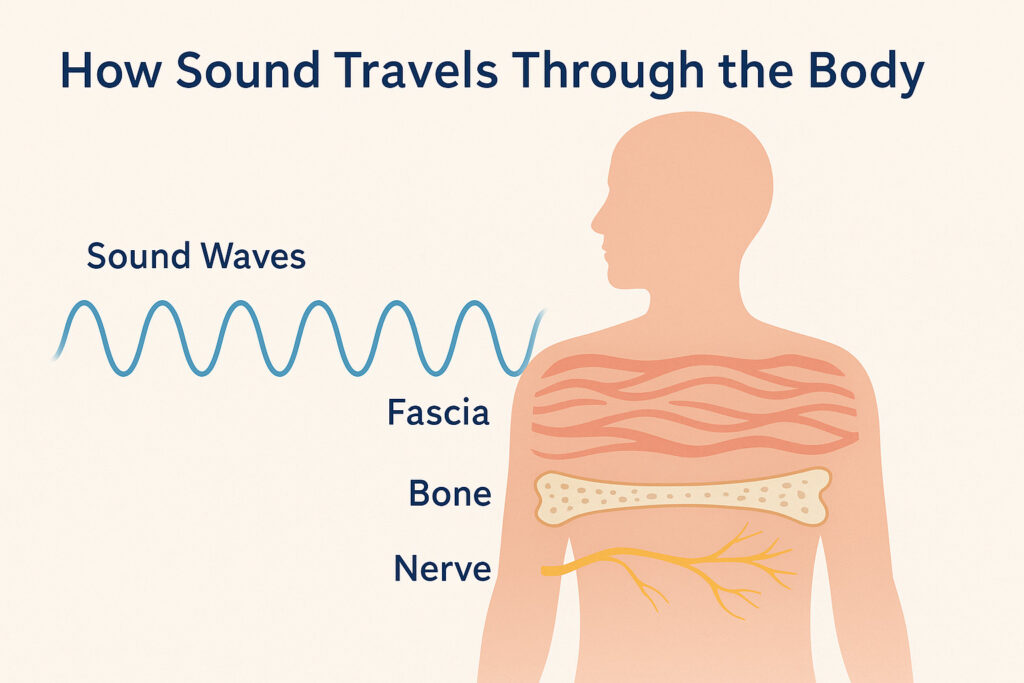Vibroacoustics: How Sound Travels Through the Body’s Fascia and Bones
Vibroacoustics is the study and application of sound vibrations transmitted directly into the body. Unlike music that reaches us mainly through the ears, vibroacoustic therapy works with low-frequency sound waves that travel through the body’s tissues, fascia, and bones — engaging both physiological and energetic systems.

The Science of Sound Transmission in the Body
Sound is a mechanical wave — a pattern of pressure and movement through a medium. In the human body, the primary mediums are:
- Fluids (blood, lymph, interstitial fluid)
- Soft tissues (muscles, fascia, organs)
- Bones (dense, rigid structures that efficiently conduct vibration)
Low-frequency sound (generally between 20–120 Hz) penetrates deeply because longer wavelengths travel more easily through dense matter. Bones, being rigid and mineral-rich, conduct vibrations faster than air — up to 3,500 m/s, compared to about 343 m/s in air. This is why we can often feel sound more intensely than we hear it during vibroacoustic sessions.
Fascia: The Body’s Vibrational Web
Fascia is a continuous network of connective tissue that surrounds and interconnects every muscle, bone, nerve, and organ. Rich in collagen fibers and water, fascia behaves like a semi-elastic, fluid-filled web. It:
- Transmits mechanical forces (including vibration) throughout the body
- Stores and releases tension
- Contains sensory nerve endings that respond to mechanical stimulation
When sound waves travel through fascia, they create micro-movements in its fibers and the fluid between them. This can:
- Increase local circulation
- Reduce fascial adhesions and stiffness
- Support lymphatic drainage
- Trigger relaxation through the parasympathetic nervous system
Bone Conduction: A Direct Path to the Nervous System
Bones are not just structural supports — they are dynamic, living tissues that vibrate. When sound waves reach bones, they:
- Conduct vibration directly to the inner ear (via bone conduction pathways)
- Stimulate mechanoreceptors in the periosteum (the nerve-rich membrane surrounding bones)
- Affect the central nervous system by influencing proprioception and balance
This is why placing an instrument like a tuning fork or a singing bowl directly on the body creates an immediate, profound sensation.
Physiological Effects of Vibroacoustics
Scientific studies and clinical observations suggest that vibroacoustic stimulation can:
- Reduce muscle tension by modulating the stretch reflex
- Enhance blood flow through rhythmic mechanical stimulation
- Lower cortisol levels and promote endorphin release
- Improve joint mobility by hydrating fascia
- Support pain relief via the gate control theory of pain modulation
The Energetic Perspective
In energy healing traditions, the body is viewed as a network of vibrating fields — from the dense vibrations of bone to the subtle frequencies of the aura. Sound is seen as a bridge between the physical and energetic bodies:
- Chakras respond to different frequency ranges
- Meridians can be “unblocked” through vibrational stimulation
- Resonance can restore harmony to areas of stagnation or disharmony
When fascia is hydrated, mobile, and free of restriction, energy flow is also believed to improve, enhancing vitality and emotional balance.
Practical Applications in Energy and Sound Healing
Vibroacoustic principles can be applied through:
- Tuning forks placed on acupressure points or bones
- Singing bowls positioned on the body
- Sound beds or chairs that deliver low-frequency vibrations
- Voice work — humming, toning, and chanting to create internal resonance
A skilled practitioner combines anatomical understanding with intuitive listening, adjusting placement, frequency, and duration to meet the client’s needs.
Conclusion
Vibroacoustics bridges the gap between science and energy healing. It is rooted in physics and physiology, yet it also resonates with ancient practices that see the body as a living instrument. By understanding how sound travels through fascia and bones, we can harness vibration not just for relaxation, but for deep structural and energetic alignment.
